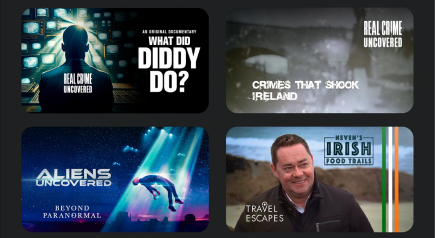Transitions like this have forced publishers to rethink, adjust and realign in every way - content, monetization, consumption, UX/UI - accounting for accompanying changes in user behavior along the way – what and how much they watch, when, where, and what they’re willing to pay. One thing is for certain, though: Video has become the dominant medium on every platform, engaging subscribers, members, consumers, social media followers, passersby, captive audiences in their homes and outside. And publishers are recognizing its value to drive engagement, retention and revenue.
Viewers retain 95% of a message when delivered through video, compared to only 10% with text.
Users spend 2.6 times more time on pages with video than those without.
Videos lead to a 60% reduction in bounce rates compared to pages with only text content.
Users aged 16 to 34 have accounts on at least seven social networks and spend an average of 2.5 hours a day on social media.
On the social front, video rules. TikTok has established itself as the pace car for short-form, mobile-friendly video while YouTube continues to be a force with longer watch times leading to higher rankings in search results and recommendations, and average view duration an important indicator of audience engagement.
And advertisers know this. Video moves people and significantly influences consumer decisions and conversions:
84% of people say that a brand's video has convinced them to buy a product or service.
Video can boost conversions by up to 80%.
87% of video marketers report that video has directly increased sales.
As we look ahead to 2025, we’ve identified seven areas of focus for publishers as they think about video and how to make it work for them.
Spurring Traffic
With at least 20% of publishers reporting their concerns about declining referral traffic volume due to fewer direct visits to publisher websites, it’s critical that they find a way to make up for some of those losses. While there is no silver bullet, the increased use of video is one way to increase viewer engagement and retention, drive new traffic, activate new audiences and hit revenue targets. And with the rise of generative AI-enabled search, the ability to find new sources of referral traffic and build a loyal audience has become even more critical for publishers. Among publishers’ core tactics is experimentation with new forms of video content and increasing their presence across social channels. 81% of respondents said they are experimenting with live streams and long-form video content, and 70% said they are focusing on short-form original vertical video for TikTok, YouTube Shorts, and Instagram. According to Digital Content Next, “Long-form video content will ultimately offer publishers more control over monetization options than short-form videos created specifically for social channels. With long-form videos, publishers can incorporate in-depth reporting that sets them apart from other content sources and encourages deeper reader engagement and return visits.”
These statistics clearly demonstrate that video has the potential to drive stronger engagement, which is good for the publisher and the advertiser.
Good Content Matters
Editorial and advertising have long wrestled over resources. While there’s no question that premium content - which often means video content - drives audiences who in turn drive advertising dollars, it’s hard to generate that kind of content without cash. A virtuous circle. The reality is that most publishers (especially these days) don’t have the resources to create enough of their own high quality video to accompany each and every story. As a result they may resort to poor substitutions, like auto-generated video which has a poor user experience, or nothing at all, leaving users and ad dollars on the table. Research has shown that the quality of video production plays a crucial role in audience engagement: 62% of consumers are more likely to negatively perceive a brand if they produce low-quality videos.
Low-production value videos, while potentially attracting initial attention, often result in shorter viewing times.
Accessing premium rights-cleared third party video content, however, can attract users, drive engagement and secure higher CPMs. Bottom line, the more high quality video, the better audience engagement, and the better the return.
Faster and Curiouser
The introduction of publisher-owned FAST channels has brought renewed optimism to an industry facing serious monetization challenges. As an advertiser-friendly platform that looks a lot like linear TV, it’s potentially a new revenue stream for publishers and a promotional platform for their core site, introducing the brand to new audiences and bringing them over. According to data from VideoElephant’s 2024/25 State of Video Report, of the millions of FAST viewers in the U.S., 72% say FAST delivers good or excellent value – more than any other kind of platform. To understand how rapidly the free ad-supported streaming TV (FAST) market is developing, it is worth looking at a few facts according to Statista’s global data and business intelligence platform publication:
In 2024, the FAST market is expected to deliver revenue of US$9.06 billion, with an expected increase to US$11.83 billion by 2027.
By 2027, the FAST market anticipates reaching 1.1 billion users.
Analysts anticipate the user penetration rate, estimated at 13.0% in 2024, will rise to 13.8% by 2027.
But, what’s become clear to channel owners after a period of trial and error is that these FAST channels require upkeep. For them to succeed, channel owners must stay up on the data, tune into the audience and reflect evolving interests. So while FAST is a great way for publishers to generate income, it takes an investment of time, money, content, expertise and potentially a partner to make them fly.
Influence and Scale
With the vast amount of content being produced daily, standing out in a crowded digital landscape is increasingly difficult. Content owners, e.g. publishers, struggle with discoverability, requiring constant adaptation to SEO algorithms and new marketing regimes. At the same time, those publishers can expand their reach, influence and revenue by licensing their content, that is, basically, syndicating it to other websites and outside of the online video space - e.g. DOOH, Retail Media. A company like VideoElephant works with publishers of all sizes to distribute their own video content and monetize it. This expands a brand’s reach, grows its influence and generates additional ad revenue. The reverse is also true, publishers without the resources to produce their own content can bolster their own by licensing high quality, rights cleared video content through VideoElephant.
The DOOH Frontier
Digital out-of-home or CTV-OOH is surging as brands try to reach consumers outside of social media and streaming platforms. According to a new report in Adweek, as many as 68.6 million U.S. adults recalled seeing a video advertisement in a physical retail environment (e.g., shopping mall, grocery store or other similar setting) during the prior 30 days, up over 6% from 2018. Ad dollars are following, says the report. In the U.S., dollars spent advertising on posters, billboards, and other OOH placements rose to $2.04 billion in Q3, according to the Out of Home Advertising Association of America (OAAA), representing a 4.3% increase compared to the same three-month period last year and an all-time high for the quarter.
And it’s not just in retail settings. We are seeing CTV OOH in a wide variety of venues including restaurants, doctors’ offices, airports, elevators, gas stations, where context counts. News, weather and travel video in an airport makes sense, and attracts eyeballs. Calming scenes of fields and oceans are well-suited for doctors’ offices and entertainment may be right for restaurants and bars.
Format Flexibility
To keep up with the video demands of Gen Z, it’s important for publishers to be prepared with enough mobile-friendly vertical video to be taken seriously. Even with TikTok probably going away, mobile viewing habits have become the norm, and audiences will seek out alternate platforms/destinations to replace what they’ve become used to. YT shorts and Instagram Reels are obvious destinations, but pubs with vertical-first strategies (like News Corp Australia) will have a leg up on publishers who are slow to adapt to vertical video. VideoElephant’s library of millions of videos, including vertical formats, enable publishers to flesh out their inventory easily and seamlessly, without investing in expensive content creation teams. VideoElephant has seen a 10X increase in vertical content ingested from content providers. And month over month, we’ve seen an average 40% increase in usage from our customers. VideoElephant now boasts one of the most diverse and deep vertical video libraries available in the market today.
AI and the Future
At the same time, says Digiday, AI is accelerating the evolution of advertising strategies: “Predictive targeting, on the fly ad creative, and more advanced tech to control ad campaigns are helping large platforms capture new dollars from offline retail media while better maintaining privacy. For publishers, a dual focus on consumer trust and innovative monetization will be critical for success if they want to peel off some of these dollars.”
AI-driven changes including regulatory involvement and consumer appetites, will result in a complicated rebooting of our publishing ecosystem, balancing efficiency with authenticity. The challenge of differentiating human-created content from AI-generated material will intensify, potentially affecting content quality perceptions. Publishers will need to leverage AI for personalization while ensuring content resonates with their audience. At the same time, there will still be a need for a human in the loop to edit and proof the content. The importance and cost of which cannot be unestimated.











